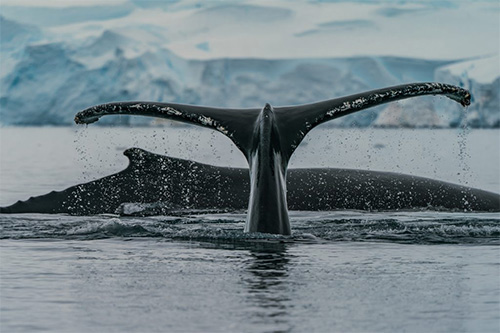|
In all mammals, average blood pressure is higher in arteries, or the blood exiting the heart, than in veins. This difference in pressure drives the blood flow in the body, including through the brain, says Dr. Lillie, a research associate emerita in the UBC department of zoology. However, locomotion can forcefully move blood, causing spikes in pressure, or ‘pulses’ to the brain. The difference in pressure between the blood entering and exiting the brain for these pulses can cause damage.
Long-term damage of this kind can lead to dementia in human beings, says Dr. Lillie. But while horses deal with the pulses by breathing in and out, whales hold their breath when diving and swimming. “So if cetaceans can’t use their respiratory system to moderate pressure pulses, they must have found another way to deal with the problem,” says Dr. Lillie.
Dr. Lillie and colleagues theorized that the retia use a ‘pulse-transfer’ mechanism to ensure there is no difference in blood pressure in the cetacean’s brain during movement, on top of the average difference. Essentially, rather than dampening the pulses that occur in the blood, the retia transfer the pulse in the arterial blood entering the brain to the venous blood exiting, keeping the same ‘amplitude’ or strength of pulse, and so, avoiding any difference in pressure in the brain itself.
The researchers collected biomechanic parameters from 11 cetacean species, including, fluking frequency, and input these data into a computer model.
“Our hypothesis that swimming generates internal pressure pulses is new, and our model supports our prediction that locomotion-generated pressure pulses can be synchronized by a pulse transfer mechanism that reduces the pulsatility of resulting flow by up to 97 per cent,”says senior author Dr. Robert Shadwick, professor emeritus in the UBC department of zoology.
The model could potentially be used to ask questions about other animals and what’s happening with their blood pressure pulses when they move, including humans, says Dr. Shadwick. And while the researchers say the hypothesis still needs to be tested directly by measuring blood pressures and flow in the brain of swimming cetaceans, this is currently not ethically and technically possible, as it would involve putting a probe in a live whale.
“As interesting as they are, they’re essentially inaccessible,” he says. “They are the biggest animals on the planet, possibly ever, and understanding how they manage to survive and live and do what they do is a fascinating piece of basic biology.”
“Understanding how the thorax responds to water pressures at depth and how lungs influence vascular pressures would be an important next step,” says co-author Dr. Wayne Vogl, professor in the UBC department of cellular and physiological sciences. “Of course, direct measurements of blood pressure and flow in the brain would be invaluable, but not technically possible at this time.”
On the Web:
'Retia mirabilia: Protecting the cetacean brain from locomotion-generated blood pressure pulses' was published today in Science.
Edited By: Mary Kauffman, SitNews
Source of News:
University of British Columbia
ubc.edlu
Representations of fact and opinions in comments posted are solely those of the individual posters and do not represent the opinions of Sitnews.
Send a letter to the editor@sitnews.us
SitNews ©2022
Stories In The News
Ketchikan, Alaska
Articles & photographs that appear in SitNews are considered protected by copyright and may not be reprinted without written permission from and payment of any required fees to the proper freelance writers and subscription services.
E-mail your news & photos to editor@sitnews.us
Photographers choosing to submit photographs for publication to SitNews are in doing so granting their permission for publication and for archiving. SitNews does not sell photographs. All requests for purchasing a photograph will be emailed to the photographer.

